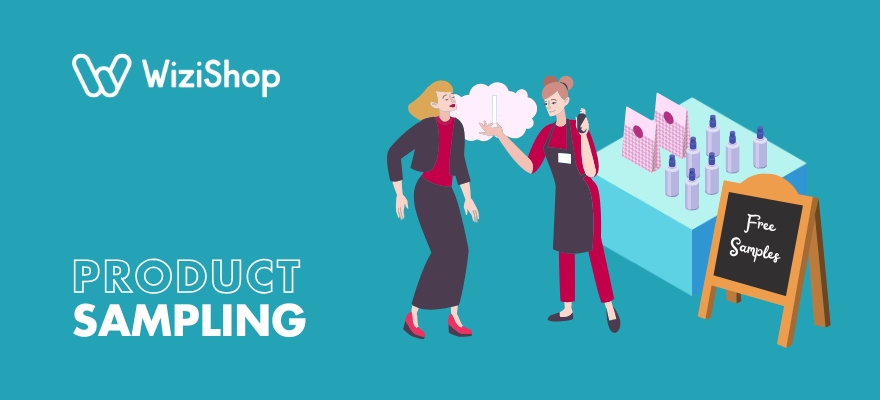When you run a business, giving away samples of your products for free may seem contradictory to your plans to make money, especially if you’re just starting out and trying to make your first online sale. However, product sampling is actually a pretty powerful strategy that can help capture consumer attention and build brand loyalty.
By giving potential customers the opportunity to experience your product firsthand, you craft an authentic connection that traditional advertising often can’t achieve. Whether you’re launching a new product, entering a new market, or looking to boost engagement with an existing offering, product sampling can be a game-changer. It not only strengthens trust but also encourages word-of-mouth marketing, drives trial, and ultimately increases conversions.
In this article, we’ll discuss the key benefits of product sampling, different methods to try, how to launch a campaign effectively to take advantage of the power of product sampling and maximize your return on investment (ROI), and common errors to avoid making when using this marketing strategy.
Table of contents
- What is the meaning of product sampling in marketing?
- Why do product sampling?
- What are different product sampling methods?
- How do you start doing product sampling campaigns?
- How do you measure success in a product sampling campaign?
- Common errors when giving away free samples for people to try
- When to launch a product sampling campaign
What is the meaning of product sampling in marketing?
Product sampling is a marketing strategy where companies distribute free or small-sized versions of their products to potential customers. This allows consumers to try the product before making a purchase, helping brands increase awareness, build trust, and drive sales.
Product sampling can take place in stores, through direct mail, at events, or via promotions on the web. It’s commonly used in industries like cosmetics, food and beverages, and consumer goods.
One of the first known examples of retailers handing out free samples of products is Benjamin T. Babbitt, a 19th-century soap manufacturer. In addition, in the 1900s, attendees of Australian agricultural shows often received product sample bags from vendors for free or for a small price, gifts that later became the branded showbags that remain popular in Australia today.
Why do product sampling?
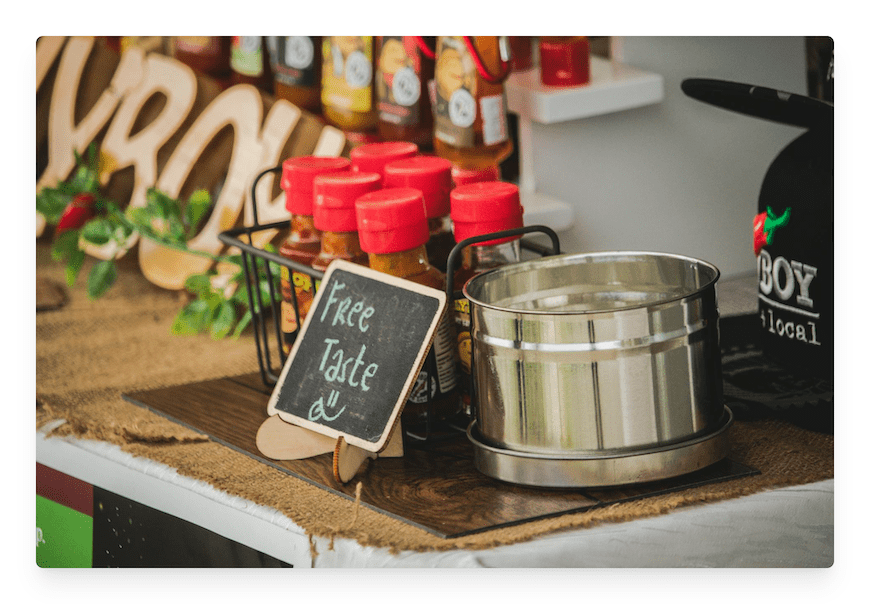
Giving away free samples of your products can provide your business with a variety of benefits. Here are some of the reasons to consider incorporating product sampling into your marketing for digital products or physical goods.
Increase brand awareness
Product sampling exposes new audiences to your brand, increasing visibility in the market. When consumers receive a free sample, they become more familiar with your brand and its offerings. This exposure is especially beneficial for startups or lesser-known brands trying to establish themselves.
Sampling also generates buzz, encouraging discussions among consumers. If a product is unique or high-quality, recipients may share their experience on social media, amplifying brand recognition. By reaching a larger audience through direct engagement, product sampling helps create long-term brand recall and encourages potential customers to explore other products from the same brand.
Build trust and credibility
Consumers are often hesitant to try new products, especially from unfamiliar brands. By offering free samples when building your ecommerce brand, you reduce the risk for customers, allowing them to test the quality without financial commitment. This firsthand experience boosts trust, making consumers more likely to purchase in the future.
When people see that a company is confident enough to give away its product, they perceive it as high-quality and reliable. Additionally, positive experiences with a sample can turn customers into brand advocates, further increasing credibility through word-of-mouth and online reviews, which help reinforce the brand’s reputation.
Improve conversion rates
Product sampling directly impacts purchasing behavior by reducing hesitation and uncertainty. When customers try a product and find it meets their needs, they’re more likely to purchase it rather than opting for a competitor. Studies have shown that consumers who receive samples tend to buy the bigger version of the product at a higher rate than those who have only seen advertisements.
In addition, when physical retailers or ecommerce stores offer samples, they create a sense of urgency, encouraging immediate purchases. By bridging the gap between curiosity and purchase, product sampling significantly improves conversion rates and long-term customer retention, whether you’re marketing to high-end consumers or budget shoppers.
Obtain feedback on your products
Sampling campaigns provide valuable consumer feedback, helping brands refine their products and marketing strategies. When you offer free samples, you can collect reviews, surveys, or direct customer responses to identify strengths and areas for improvement.
Understanding consumer preferences, taste, texture, packaging appeal, or usability allows you to make necessary adjustments before a full product launch. Feedback also helps identify which groups of people respond best to the product. This data-driven approach minimizes risk, ensures buyer satisfaction, and enables you to tailor your messaging for better engagement and sales.
Leverage word-of-mouth marketing
Product sampling often leads to organic word-of-mouth promotion. When consumers try and enjoy a product, they naturally share their experience with family, friends, or social media followers. A survey by Fizz Experience interviewing consumers who had recently attended an in-store sampling event found that 58% of them planned to tell others about the new products they discovered via the sampling.
Positive reviews and recommendations are highly influential, as people trust opinions from peers more than traditional advertising. This kind of organic buzz can expand the product’s reach far beyond the initial sample distribution.
What’s more, brands can encourage samplers to leave online reviews, boosting credibility and online visibility. Influencer collaborations, where samples are sent to bloggers or content creators, further enhance word-of-mouth marketing, increasing product exposure exponentially.
Gain a competitive advantage
In a crowded marketplace, offering free samples can differentiate a brand from its competitors. When consumers have multiple choices, sampling provides an opportunity to prove a product’s superiority. It allows your brand to stand out by showcasing your unique qualities, such as better taste, effectiveness, or superior ingredients.
Competitors who don’t offer samples may struggle to attract customers willing to try something new. By giving consumers direct exposure to a product, sampling reduces the likelihood of them choosing a competitor’s offering, effectively increasing market share.
Promote new products effectively
Launching a new product can be challenging, as consumers are often hesitant to buy something unfamiliar. Product sampling is a great way to introduce a new item to the market and get your foot in the door without relying solely on advertising.
When potential customers try a new product risk-free, they’re more likely to consider purchasing it. In fact, according to a study done by Marsh Supermarkets, 68% of shoppers were convinced to buy a product after sampling it.
In addition, sampling can generate excitement and anticipation for a launch, especially if combined with promotional campaigns. It also helps brands gauge consumer response, allowing them to make final adjustments before a widespread release. A successful sampling strategy can accelerate the adoption of new products and drive initial sales.
Boost engagement
A well-executed product sampling campaign fosters direct interaction between consumers and brands. Unlike traditional advertising, which relies on passive exposure, sampling encourages active participation.
Whether distributed at in-store demos, events, or through online requests, samples create a hands-on experience that enhances consumer interest. People appreciate the opportunity to test products, which increases their emotional connection to the brand and helps bolster your customer acquisition strategy.
Moreover, interactive sampling events allow companies to educate customers about product benefits, usage, and ingredients, leading to stronger engagement. This interaction can turn one-time samplers into loyal customers who feel a personal connection with the brand.
Enjoy a cost-effective marketing tactic
Compared to traditional advertising methods, product sampling offers a high ROI. While there is an upfront cost in producing and distributing samples, the potential for increased sales and brand loyalty makes it worthwhile. Many traditional advertisements struggle to convert interest into purchases, whereas sampling eliminates hesitation by allowing consumers to experience the product firsthand.
Furthermore, digital sampling methods, such as sending samples through ecommerce platforms or social media campaigns, further reduce distribution costs while reaching a highly targeted audience. When executed strategically, product sampling delivers significant long-term growth with a relatively low marketing spend.
What are different product sampling methods?
Here’s a list of different product sampling methods commonly used in marketing and research to promote products or gather feedback:
- In-store sampling: Also referred to as traditional sampling, this entails offering free samples to customers directly in retail stores. Example: Grocery stores offering food tastings near the product display.
- Event sampling: With this method, you distribute samples at events such as trade shows, festivals, or conferences. Example: Beverage companies giving out samples at music festivals.
- Direct mail sampling: This involves sending product samples directly to consumers’ homes via mail. Example: Beauty brands sending new product samples to loyal customers.
- Digital or online sampling: As the name implies, this strategy is about offering free samples or trial versions through online platforms, sometimes after filling out a form. Example: Shoppers requesting a skincare sample from a brand’s website.
- Influencer/product seeding: Here, companies will send free products to influencers or brand ambassadors to try and promote. Example: Fitness brands sending protein bars to health influencers.
- Street/guerrilla sampling: This means handing out samples in high-traffic public places like malls, parks, or busy streets. Example: Coffee brands giving free cups outside office buildings in the morning.
- Partner sampling (cross-promotions): Involving two or more entities, it involves distributing samples through partnerships with complementary brands. Example: A granola brand including samples in a yogurt brand’s packaging.
- Trial size sales (paid sampling): You might alternatively opt to sell trial-size versions at a reduced price to encourage trial without giving them away for free. Example: Mini versions of cosmetics or snacks at checkout counters.
- Sampling via loyalty programs: This technique entails offering exclusive samples to members of a brand’s loyalty program. Example: VIP customers receiving new product samples as part of their rewards.
How do you start doing product sampling campaigns?
Ready to begin sampling your products for potential buyers to enjoy? Follow these simple steps to get started!
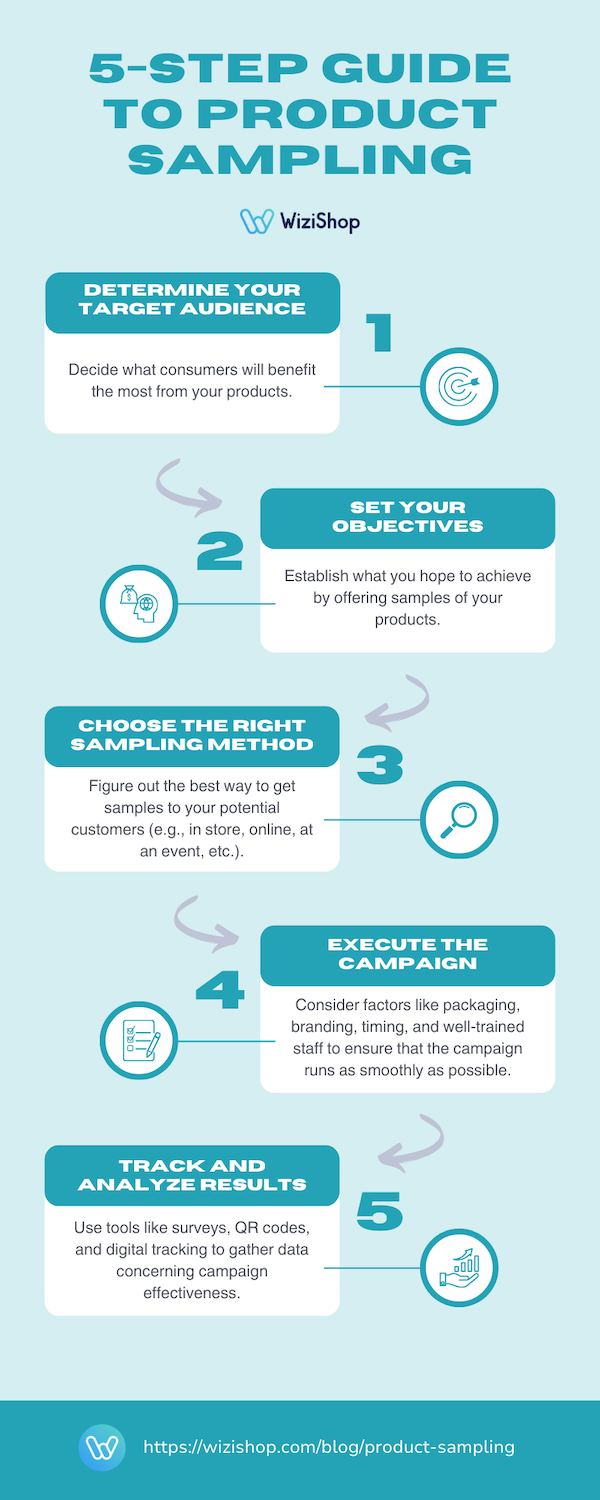
1. Determine your target audience
Just like when you’re getting ready to launch an online store, determining your target audience is the first step when preparing a product sampling campaign. Who would benefit most from your product? Where are they likely to engage with your brand?
In your research, be sure to consider customer demographics (age, gender, location), shopping habits, preferences, and pain points. For your campaign to be effective, it’s imperative that any samples you give to shoppers are items that they’re actually interested in. Otherwise, any initial investment you’re putting into your sampling efforts will simply be a waste of money!
Say that your online store sells pet food. If a customer buys a 5-lb bag of turkey-flavored dry food for dogs, you probably wouldn’t want to add a free sample of the same food in their order—they don’t need to be convinced to buy that item. Instead, pique their curiosity with a sample of treats, a different flavor of dry food, or your newest canned food for pups.
2. Set your objectives
Next, you’ll need to clearly outline the goals of your sampling campaign. For instance, are you aiming to increase brand awareness, generate leads, collect feedback, or boost sales? Deciding on what you hope to achieve will assist you in figuring out what to offer, when to offer it, and the duration of the offering.
You’ll also need to determine exactly who you want to try your product. Although you’ll have already established your target audience in the previous step, it’s time to get a bit more specific. Using the pet food example again, you might choose to target online shoppers only with your samples for instance or perhaps instead partner with an animal rescue organization to give away samples at an event to connect with customers in person.
Finally, how do you plan to measure the success of your campaign? You can launch the most creative, appealing product sampling campaign in the world, but if you don’t analyze the results, you won’t know if it actually did your business any good.
3. Choose the right sampling method
The third step involves selecting a distribution method that aligns with your audience and objectives. Whether you opt to do in-store sampling, influencer seeding, event-based sampling, direct mail, or online requests, you’ll want to make sure that it makes sense for your business.
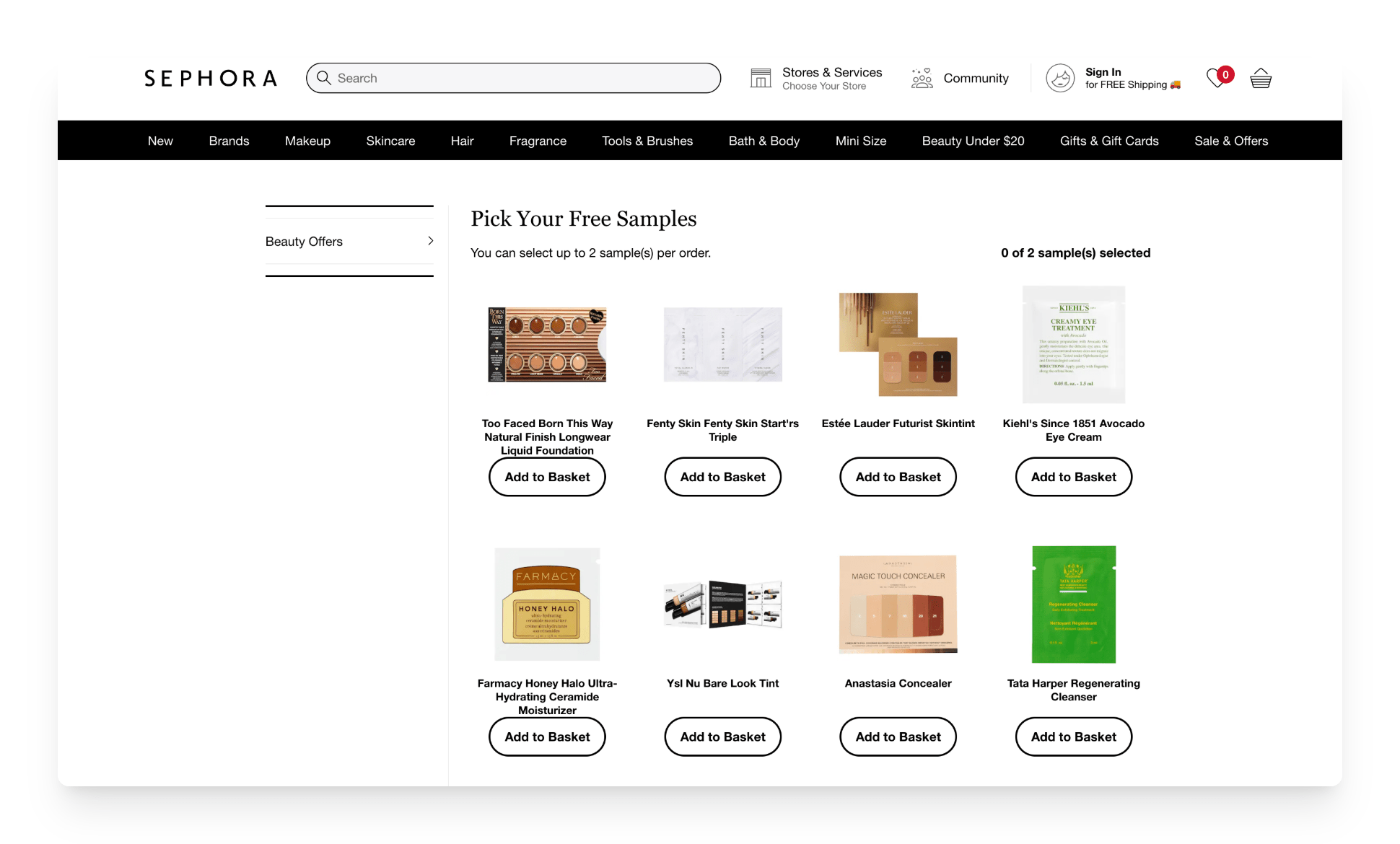
Sephora offers free samples with every order
The right method ensures relevant feedback, efficient resource allocation, and better conversion rates, ultimately enhancing campaign effectiveness and product-market fit. While internet sampling strategies are generally relatively simple, those occurring at brick-and-mortar locations will often require a bit more planning in order to be successful.
In this case, where you set up your sampling station is crucial. Rather than hiding out at the back of the store, for example, where it’ll be difficult for shoppers to find you, plan to offer samples at the entrance or at the checkout counter to see the most foot traffic.
4. Execute the campaign
Now that you’ve decided who to target with your sampling, what you wish to achieve, and what method to use to get your samples out there, you’re ready to go ahead with your campaign. It’s time to prepare logistics, train staff (if applicable), and launch the sampling program.
When executing a product sampling campaign, consider several essential factors to ensure success:
- Packaging: Your product samples should feature packaging that is attractive, practical, and reflective of your brand, leaving a lasting impression.
- Branding: Remember to verify that your branding is consistent across all materials to reinforce recognition.
- Timing: Align campaigns with peak seasons, product launches, or relevant events for maximum impact.
- Well-trained staff: For in-person sampling, a well-trained, engaging team is essential to create positive interactions, convey key product benefits, and gather valuable customer feedback.
5. Track and analyze results
After your product sampling campaign is finished, it’s important to carefully examine the results, tracking key metrics to evaluate the effectiveness of the campaign. Metrics you might consider taking a look at include customer feedback, conversion rates, social media engagement, and ROI.
To help you during this step, you can avail of tools like surveys, QR codes, and digital tracking to gather data. Analyze this information to identify what worked, areas for improvement, and insights into customer preferences.
This step helps refine future campaigns, optimize marketing strategies, and justify budget allocation. Without proper measurement, it’s impossible to gauge impact, learn from outcomes, or make data-driven decisions for future success.
How do you measure success in a product sampling campaign?
After putting in the work to offer product samples in the best way possible to consumers, how do you know if your efforts have paid off? Check out the some of the various ways to measure success in a product sampling campaign:
- Redemption or conversion rates: Track how many recipients of the sample made a purchase afterward, using unique promo codes or QR codes.
- Sales lift: Compare sales data before, during, and after the campaign to measure the direct impact on revenue.
- Customer feedback: Collect qualitative data through surveys, reviews, or feedback forms to gauge satisfaction and product perception.
- Engagement metrics: Monitor social media mentions, shares, hashtags, and user-generated content related to the campaign.
- Lead generation: Measure the number of new contacts or sign-ups collected through the campaign.
- Trial-to-purchase ratio: Evaluate how many people who tried the sample became regular customers.
- Return on investment (ROI): Calculate the financial return compared to the cost of running the campaign.
- Brand awareness: Use brand recall studies, website traffic analysis, or social media reach to assess increases in visibility.
- Repeat purchase rate: Track how many first-time buyers from the campaign make repeat purchases.
- Market penetration: Assess growth in new markets or demographics targeted during the campaign.
Common errors when giving away free samples for people to try
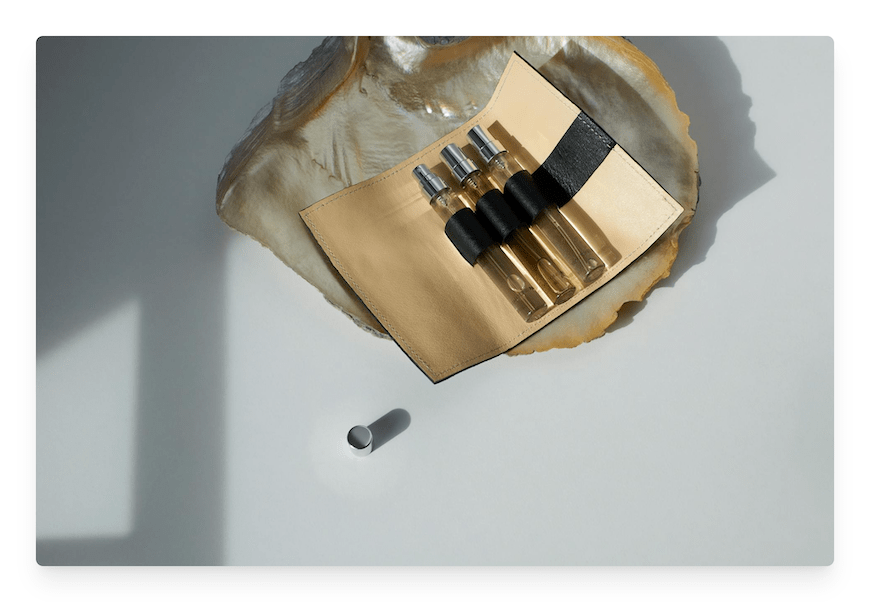
Product sampling, when implemented well, can be an effective marketing strategy for your business. However, it’s certainly not without its challenges and bumps in the road!
Here are several common errors businesses often make when it comes to product sampling, along with tips to avoid them.
Targeting the wrong audience
One of the biggest mistakes brands tend to make when launching product sampling campaigns is trying to reach the wrong groups of consumers. Distributing samples to people who have little interest or need for the product leads to wasted resources and low conversion rates. If the sample doesn’t reach prospective buyers, it won’t drive sales or allow you to gather meaningful feedback.
To avoid targeting the wrong shoppers, clearly define your principal audience based on demographics, interests, and behaviors. You can also use data from past campaigns or market research to identify ideal sampling opportunities.
Using a poor follow-up strategy
Another major product sampling error is failing to engage with customers after they’ve received the sample, missing out on valuable feedback or conversion opportunities. Without an effective follow-up strategy, you can’t measure the campaign’s effectiveness or nurture leads into loyal customers.
This can be prevented by collecting contact information during the sampling process (e.g., through sign-ups or QR codes). What’s more, you can implement follow-up emails, surveys, or exclusive offers to encourage purchases and gather insights.
Providing a low-quality presentation or product experience
Lastly, offering poorly packaged, incomplete, or underwhelming samples that don’t reflect the product’s true value can reduce the effectiveness of your sampling campaigns. A bad first impression can harm your brand’s reputation, even if the full product is high quality.
Avoid this by ensuring that the sample size is enough for customers to experience the product’s benefits fully. Also prioritize investing in attractive, branded packaging that communicates professionalism and quality.
When to launch a product sampling campaign
A product sampling campaign will be most effective when you aim to boost brand awareness, introduce a new product, or drive customer engagement. Launch one when entering a new market to generate buzz and build trust, especially if your product offers a unique value that people need to experience firsthand.
It’s also ideal when targeting specific demographics, allowing you to gather feedback, refine your offering, and generate word-of-mouth marketing. Sampling can help reignite interest in an existing product, particularly if sales are stagnating.
You’ll also want to consider seasonal timing—aligning with holidays, events, or peak demand periods can maximize impact. If you’re confident in your product’s quality and believe a trial will convert prospects into loyal customers, a sampling campaign can deliver strong ROI. Just be sure that you have the budget, logistics, and follow-up marketing strategy in place to capitalize on the interest it generates.


